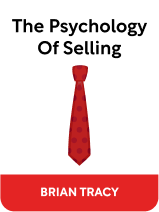

This article is an excerpt from the Shortform book guide to "The Psychology Of Selling" by Brian Tracy. Shortform has the world's best summaries and analyses of books you should be reading.
Like this article? Sign up for a free trial here .
Do you work in face-to-face sales? What is the key to converting a curious prospect into a satisfied customer?
Once a sales prospect has shown an interest in your product, you’ll need to engage them in a conversation that allows them to open up and tell you what exactly they are looking for. To maximize your chances of closing, follow these three sales tips for success: 1) position yourself as trustworthy, 2) ask questions, and 3) emphasize your product/service’s key benefits.
We’ll discuss each of these concepts below.
1. Position Yourself as Trustworthy
Our first sales tip for success is to position yourself as trustworthy—as a friend or advisor rather than a sales person. Focus on helping the prospect rather than selling your product. This makes her feel your meeting is about her, not you, and dramatically reduces the likelihood of rejection.
It’s also crucial that you come across as honest, or your customer will reject you immediately. Therefore, don’t oversell the benefits of your product, but instead explain simply and truthfully how your product or service can help her.
2. Ask Questions
To encourage an open conversation, ask questions. People love to talk about themselves, so let them. More often than not, if you let a customer talk, she’ll reveal to you what would convince her to make a sale. Asking questions has several advantages:
- Asking questions puts the spotlight on the customer, which is where it should be. Again, people like to be the center of attention, and keeping the focus of the conversation on your customer rather than on you or your products keeps her happy and makes her feel her needs are central. It increases the likelihood of a sale.
- Asking questions puts you in the driver’s seat. In general, in any dynamic between two people, the person who asks the questions is in control of the conversation, directing the topics and the flow, and the person responding is in the less dominant position. If your customer asks a question of you, you can regain control of the conversation by saying, “That’s a great question. Can I ask you something first?”
Three guidelines for asking questions are:
- Ask open-ended questions: questions beginning with words like what, when, how, where, and why, that can’t be answered with a simple yes or no. Examples of good questions might be:
- “How have you been managing this procedure up to now?”
- “How has that been working out?”
- “What would you like to see happen in the future?”
- “What’s one thing you’d need to know in order to move ahead with our product?”
- Allow for pauses: This might seem awkward at first (most people are uncomfortable with silences in conversation), but giving your customer space to digest and reflect will convey a pressure-free interaction, making the customer feel more in command and therefore more likely to say yes to your sale—nobody likes to feel pressured into a sale, so the more you can create a relaxed atmosphere, the more likely you are to be successful.
- Make your customer feel heard: Lean forward, nod, and smile. Don’t interrupt. Make her feel comfortable and safe opening up to you.
3. Emphasize Your Offering’s Key Benefits
When a customer buys a product or a service, she’s actually buying a benefit—a solution to a problem or a need—and not a specific item. She cares only about how your product will help her or her business. Accordingly, when opening a conversation with a potential customer, state your idea’s benefit up front. Anything else—a description of your product, or an endorsement of your service—makes your presentation about you, not her, and will put her off.
It’s critical that you focus your presentation on the benefits she values most, and minimize your focus on benefits she doesn’t care as much about. The 80/20 rule we referred to earlier applies to benefits as well as to sales success: 80 percent of sales will be based on the 20 percent of benefits that are most important to a customer; the rest of the benefits won’t matter to her. If you spend too much time talking about benefits that are lower on her priority list, you may lose the sale, as she may end up feeling that you don’t fully understand her.
In addition to identifying the key benefits your customer is looking for, identify the key objection that will make her hesitate. Every customer has one primary reason that will prevent her from buying. Your job is to direct her focus to the key benefits and make her feel they outweigh her key objection.
Focus on What It Does, Not on What It Is
A benefit is how a product or service meets a need. Therefore, underscore what your product does rather than what it is. Your customer won’t care that, for example, your payroll system is built with XYZ software—she wants to know how it will make her payroll process easier and therefore save her time and money: what it will do.
Keep in mind that companies are most concerned with profits, so show how your product or service can increase profits either by increasing revenues or cutting costs—or both. Within that overall guideline, there are slight differences in what might matter most to certain types of businesspeople. Consider what type of customer you’re dealing with when framing your offer’s benefits.
- Entrepreneurs and small businesses are interested in sales, cash flow, communicating to customers, and the logistics of delivering their products efficiently. They’re not as interested in the nitty-gritty internal details of their operations.
- Retail businesses are generally only concerned with net profits.
- Larger businesses are interested in products that help boost productivity, cut costs, or increase cash flow.
Overall, a business customer of any size wants to know three things:
- Will this product or service pay for itself?
- How long will it take to pay for itself?
- How can I be sure that it will?
Don’t Focus on Quality
Many salespeople devote a lot of time convincing a customer of the quality of their product. However, most people assume products work properly or they wouldn’t make it to market, and therefore, they are often not impressed with boasts about quality.
Usually, quality is less important to a customer than basic utility. For example, if she’s looking for a car that will get her reliably to work every day with decent fuel efficiency, she won’t be interested in the exceedingly high quality of a Ferrari.
You should focus on quality only in two situations:
- Your product is of higher quality than a competitor’s and yours has a lower price.
- Your product’s quality has direct benefits that will matter. If this is the case, directly link your product’s quality to the benefit your customer will get from it. For example, if someone needs a snowmobile that won’t break down in Alaska and leave them stranded in the frozen tundra, quality clearly matters in this case, and you should emphasize the benefit of it.
Position It as an Advancement
Position your idea as an improvement over something already known. Most people are wary of something completely new and different, as it’s a risk: It might not work, and the customer might find she’s wasted her money. It’s usually better to show how your product is an advancement of existing technology or ideas, so your customer feels secure that it will do what it promises.

———End of Preview———
Like what you just read? Read the rest of the world's best book summary and analysis of Brian Tracy's "The Psychology Of Selling" at Shortform .
Here's what you'll find in our full The Psychology Of Selling summary :
- How to dramatically increase your sales
- How to know what your customers are thinking
- Brian Tracy's 10 guidelines for success






